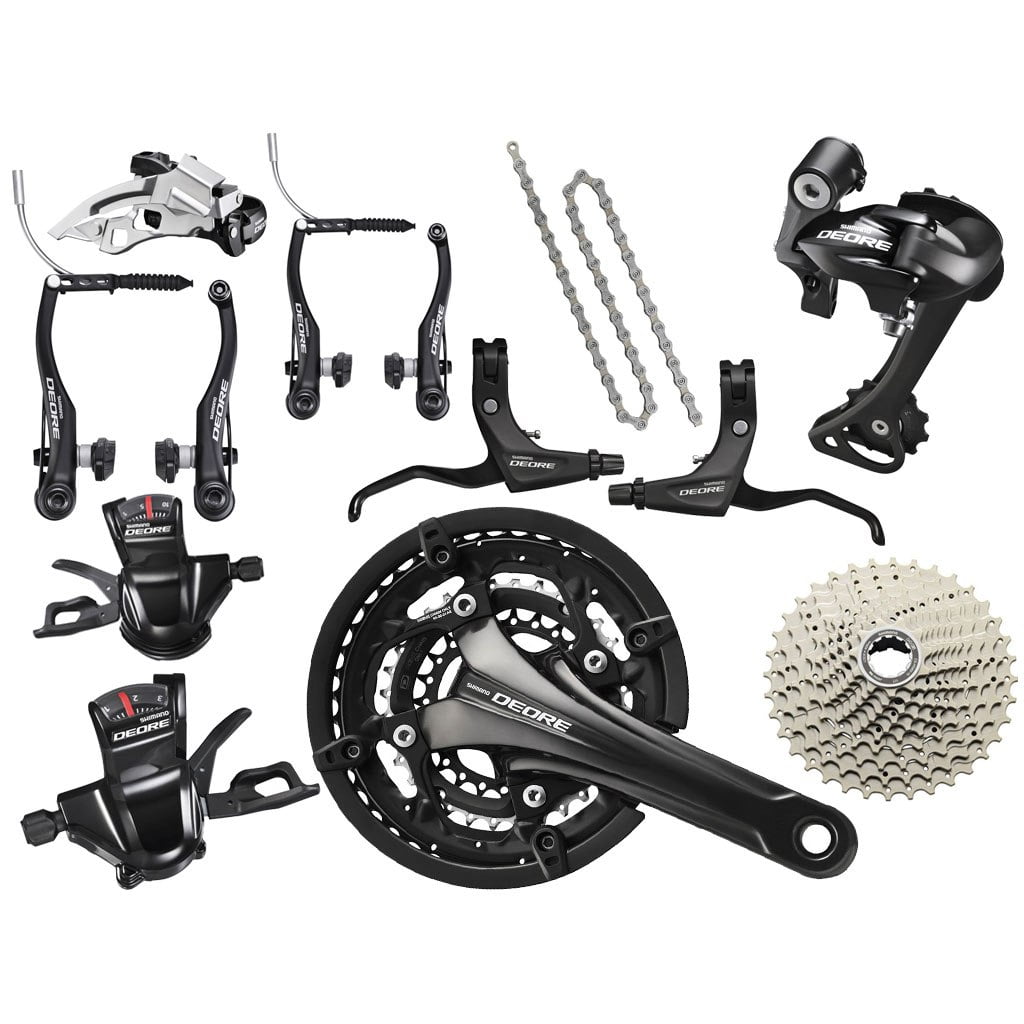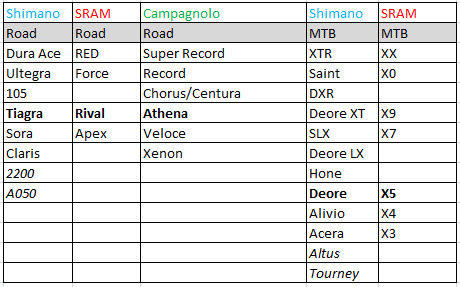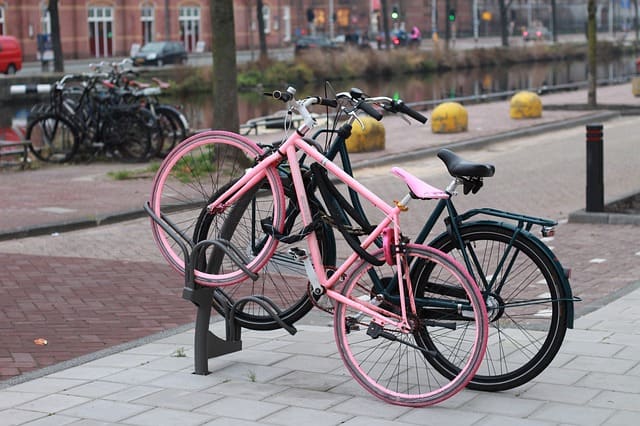An article for those entering (or returning to) the world of cycling. I answer the frequently asked questions, along with a few tips. Which bicycle should I buy? Trek, Cannondale, Pinarello…? Which bicycle is the best?
Read this article first, because it explains the basics. Separate articles deal in more detail with particualr bike types:
- Road bicycle buying guide
- Mountain bicycle (MTB) buying guide
- Trekking bicycle buying guide
- City bicycle buying guide
- Commuting bicycle buying guide
- BONUS: Is it better to buy a new or a used bicycle?
- Kids’ bicycles – how to pick the right size?
Makes – Cannondale, or Scott?
Trek, Cannondale, Scott, which one is the best? It doesn’t matter: each manufacturer uses various classes of frames (mostly all made in China) and equipment (usually Shimano or SRAM made). So a more expensive Trek, with equipment of higher class, can be better than a cheaper Cannondale – and vice versa.
As long as bicycle rolls and brakes (not breaks 🙂 ) well, it’s not bad.. After some experience, one will see for themselves which kind of bicycle suits them best – until then, a cheap old bicycle is always a good start. This article explains what too look at when choosing a bicycle, with some tips, but in the end everyone chooses for themselves and.
Lego cubes
Bicycle consists of a frame and parts mounted on it: wheels, brakes, saddle etc. Bicycle quality depends on the quality of built in parts. That is why make is completely irrelevant – all that matters is the equipment that is mounted on the bicycle.
The most important thing is the frame. It determines bicycle ride characteristics and ride quality, comfort, riding position. Frame is the spine and the heart of the bicycle. All the other equipment is picked according to the chosen frame, so a mistake in frame choice is the hardest (and the most expensive) to correct.
The second most important choice are are wheels and hubs. The biggest improvement to ride characteristics of a bicycle is made with addition of quality wheels (OK: and tyres, but tyres are cheaper, simpler to change and are a consumable).
Finally, not affecting ride, but crucial for safety: good quality brakes.
The rest of equipment is less crucial and easier to replace. Cheap shifters will make shifting a bit slower, but will work and won’t affect ride and safety.
All these parts can be bought separately. However, it costs half the price when it is all bought with the bicycle – already assembled. That is why it is important, when buying a new bicycle, to make sure it has the frame, wheels and groupset of one’s choice and quality level (or better) – it costs a lot more to later buy and replace parts separately.
1. Frame
First one needs to decide what kind of bicycle is required. A road bike, a MTB, city bike etc. This link is very helpful, just answer a few questions on planned use and get a suggested best type for the planned use: Which type of bicycle suits my needs?.
Second, choosing correct size frame for the rider: How to choose a correct frame size.
Frame material – aluminium, steel or carbon?
Carbon fibre is the lightest, but is the least resistant to damage. Carbon fibres don’t rust, but if paint is damaged, moisture can get in and affect glue holding fibres together – effectively damaging the frame, like rust would damage a metal one.
Aluminium is of medium weight, medium resistance to damage, but doesn’t corrode (except in salty conditions – winter, or sea-side). In places where paint gets chipped, a thin surface oxide layer (rust) is formed, protecting the frame from further rusting (unlike steel, where the process continues deeper, damaging the frame). With a note that salty slush on winter roads can eat through the protective oxide – so for winter riding aluminium can’t be considered to be rust-proof.
Steel is the strongest, the most damage resistant and can be welded back for a quick fix in any workshop. It is however, the heaviest frame material, that rusts if not taken care of, although It won’t go bad after a few winters riding.
Titanium is somewhere between steel and aluminium. It is more rust resistant than steel and more damage resistant than aluminium. Titanium frames are a bit lighter than steel ones, a bit heavier than aluminium ones and more expensive than both.
Price here does matter. The cheapest carbon fibre frame costs as much as the most expensive steel one (roughly speaking). Expensive, high quality steel frame will probably perform better than low quality cheap carbon one. Except it would probably still weigh more.
Aluminium is probably the best bang for the buck at this moment. If one is not certain which frame material to choose, can’t go wrong with aluminium. Except for long distance touring – steel is a must for such use – durability and ease of repairs are of high priority.
Buying a frame separately, of some decent quality costs around 200 euros for a metal frame. A good quality frame goes from 500 to 1000 euros. When buying a complete bicycle, expect to get a budget (but decent) frames on most bicycles that cost under 1000 euros.
For those interested, I explained in great detail all the facts about bicycle frame materials (carbon, steel, aluminium, titanium…).
2. Groupset
Detailed explanation what a groupset is: Groupset.
Explanation of groupset quality classes: Equipment classes.
Shortly: groupset consists of brakes, derailleurs, brake and derailleur levers, crankset, rear sprockets and chain.

Front and rear derailleurs, shifters, brake levers, V-brake callipers, crankset, sprockets and chain.
Quality classes of equipment are shown in the table below:

Bold is the middle class – where the “bang for the buck” is as good as it gets. After that, for lighter weight and perhaps better function, one has to pay a lot more. For reliable functioning and recreational use, Acera level is the minimal quality for MTB and Claris for road bicycles. And same levels of other producers.
Complete groupset of middle class is around 300 euros (when bought with the whole bicycle, it comes out a lot cheaper).
3. Wheels
Part that is easily changed, swapped. Good ones have quality rims, spokes and hubs. As far as hubs go, Shimano offers best “bang for the buck”.
This is where bicycle producers often cut costs, since no one pays attention to what make and class are wheel hubs. You will often see top class rear derailleur with budget wheels on the same bicycle.
Post explaining wheel construction: Wheels and spokes.
Post explaining (rear) hub types: Rear hubs.
A decent-quality wheel can be built for around $80 + the costs of labour.
4. Brakes
When it comes to brakes, quality ones, whether they are road, V-brake, or disc brakes, all work well. Here it is recommended going above bare minimum class equipment. Shimano Deore (or equivalent class of other producers, whether road, or MTB brakes) and higher is good. While shifters and derailleurs will work fine (if a bit slower) in Acera or higher class, when it comes to brakes, good stopping power and modulation are crucial.
If disc brakes are a choice, good quality hydraulic brakes are the best, but the most expensive. If one is not riding in mud or snow a lot, good quality rim brakes will do the job almost as well as disc brakes – for a lower price and weight.
Cheap brakes – whether disc or rim brakes – should be avoided.
Post on various brake mounting systems on forks (Brake attachment system paragraph): Bicycle fork.
Post on braking technique: Braking technique.
A new set of decent V-brakes costs around 75 euros – calipers, levers, pads. A set of good hydraulic brakes is around 150 euros (with discs included). Mechanical disc brakes are somewhere in between. When bought with the complete bicycle, it costs a lot cheaper.
5. Suspension – shock absorbers
Cheap (bad) ones make bicycle a lot heavier and actually worsen the effect of road bumps. Good ones make bicycle grip better during braking, turning, riding, they make the ride more comfortable.
Every shock absorber still makes the bike heavier, compared to a rigid frame bicycle. They all require servicing, which is not cheap – some 15 euros for every 10 to 50 working hours.
Good new shock absorber costs well above $200. If a new bicycle with shock absorbers costs under $1000, shocks are probably of a lesser quality – do double check.
The pros and cons of having suspension on your bicycle
Conclusion – author’s personal opinion
Those who know what kind of bike is the best for them don’t need to read this post at all. Those who don’t will probably be best off buying a cheap rigid MTB as the most universal bicycle. Then, after a year of riding, once they are familiar with what kind of riding they usually do and what bothers them most on their current bike, they will have much more chance of making a second bike purchase a good one. Choosing bicycle type, size, equipment is highly individual and everyone must choose for themselves.
I wrote separate articles about:
- Road bicycle buying guide
- Mountain bicycle (MTB) buying guide
- Trekking bicycle buying guide
- City bicycle buying guide
- Commuting bicycle buying guide
- BONUS: Is it better to buy a new or a used bicycle?
- Kids’ bicycles – how to pick the right size?
Tips on how to check a second hand bicycle – Buying a used bicycle:

Last updated:
Originally published:

